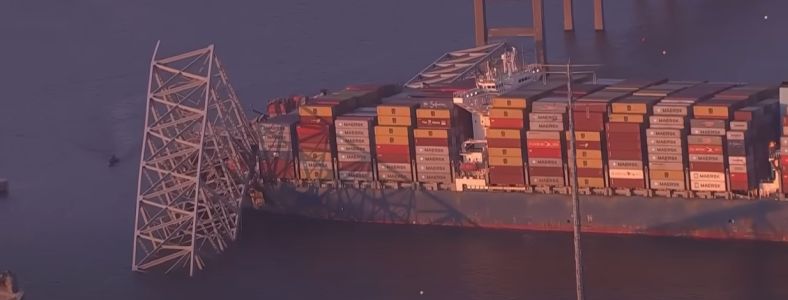 At approximately 1:30 AM this morning, the Singapore-flagged, 10,000 TEU container ship, MV Dali struck the southern support pillar of the Francis Scott Key Bridge, spanning the Patapsco River at the entrance to the Port of Baltimore, Maryland. The impact collapsed the main spans of the 1.6-mile-long bridge.
At approximately 1:30 AM this morning, the Singapore-flagged, 10,000 TEU container ship, MV Dali struck the southern support pillar of the Francis Scott Key Bridge, spanning the Patapsco River at the entrance to the Port of Baltimore, Maryland. The impact collapsed the main spans of the 1.6-mile-long bridge.
There are no reported injuries aboard the ship. Maintenance workers on the bridge and an unknown number of vehicles were thrown into the river when the bridge collapsed. Two were rescued from the water while at least seven are reported to be missing.
The crew of the container ship issued a “mayday” saying that it had lost power and propulsion before hitting the bridge, the authorities said, calling it an accident. Video just before the collision shows the ship’s lights going out twice before veering off course. The ship had two pilots onboard, according to a statement by its owners.
The Dali is owned by Grace Ocean Pte Ltd, a Singapore-based company owned by the Abe family of Japan, and is under charter by Maersk.
“We can confirm that the container vessel Dali, operated by charter vessel company Synergy Group, is time chartered by Maersk and is carrying Maersk customers’ cargo. No Maersk crew and personnel were onboard the vessel,” said a Maersk spokesperson.
The collapse of bridge forced a closure of the Port of Baltimore, and it’s likely to have a major impact on port operations and on regional shipping for the foreseeable future.
“This is a major disaster and will create significant problems on the US East Coast for US importers and exporters, wrote Lars Jensen, CEO of Vespucci Maritime, on LinkedIn. “The bridge collapse will mean that for the time being it will not be possible to get to the container terminals- – or a range of the other port terminals — in Baltimore. … Additionally this means the cargo already gated into the Baltimore terminals would have to either wait an unknown period for the sealane to reopen, or be gated back out and shifted to a different port.”
The Port of Baltimore handles more autos than any other port in the nation. It also handles containers, coal, liquified natural gas and dry bulk tonnage, and it also operates a cruise ship terminal.
The port ranked 17th in the country in total tonnage entering and leaving in 2021, according to the Bureau of Transportation Statistics’ 2024 report to Congress.
The Francis Scott Key Bridge was a steel arch continuous through truss bridge spanning the lower Patapsco River and outer Baltimore Harbor carrying Maryland Route 695 in Baltimore, Maryland, United States. The main span of 1,200 feet (366 m) was the third longest span of any continuous truss in the world.
Video of Dali Striking Key Bridge
Cargo ship loses power, crashes into the Baltimore Bridge
AIS Track of Dali
Container ship DALI struck and collapsed Francis Scott Key Bridge
Thanks to Alaric Bond for contributing to this post.

M/V Dali’s engine is VW.?
I’ve never had any problems with VW engines?
This is the best breaking news article I’ve read so far of the accident.
I read MAN/B&W.
I saw that this ship has only one engine and one screw. Is that normal on this size vessel? Thanks.
Thankss, Linda.
Craig, most merchant vessels, including container ships have a single engine and single screw, unless there is a specific reason to use multiple engines, single engines and screws are more fuel efficient.
Baltimore/Suez: are ships and infrastructure adapted to each other?
The increase in the size and mass of container ships raises the question of their compatibility with the infrastructure supposed to accommodate them.
https://market-insights.upply.com/en/baltimore/suez-are-ships-and-infrastructure-adapted-to-each-other?utm_campaign=Logistique%20et%20Transport%20US&utm_content=181207025&utm_medium=social&utm_source=facebook&hss_channel=fbp-248039519074498&hsa_acc=320691558533271&hsa_cam=23849809753070539&hsa_grp=23849809819660539&hsa_ad=120206836878550540&hsa_src=fb&hsa_net=facebook&hsa_ver=3